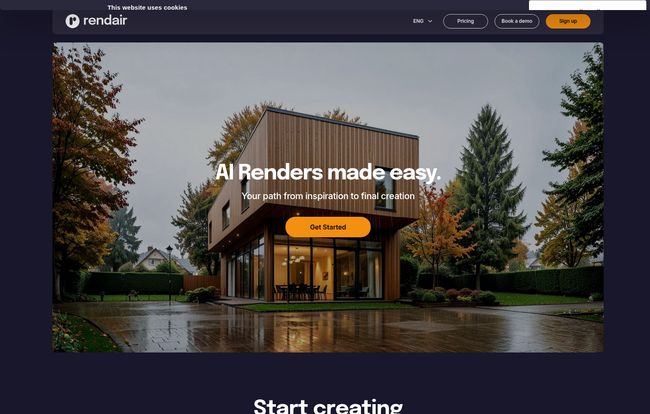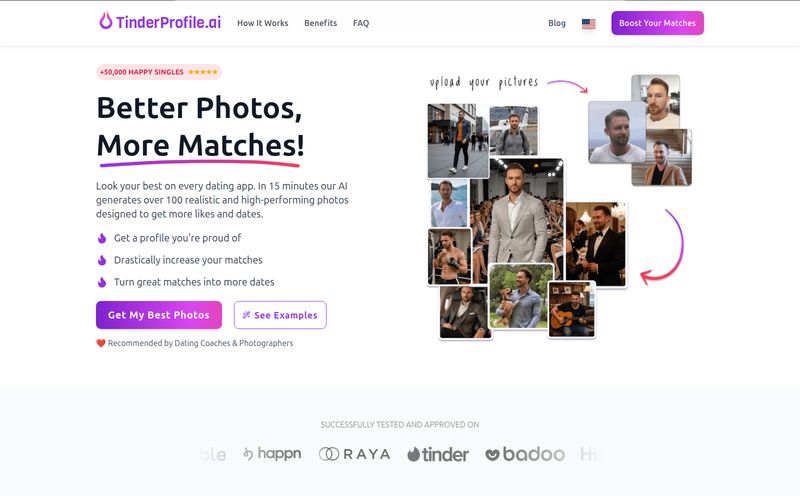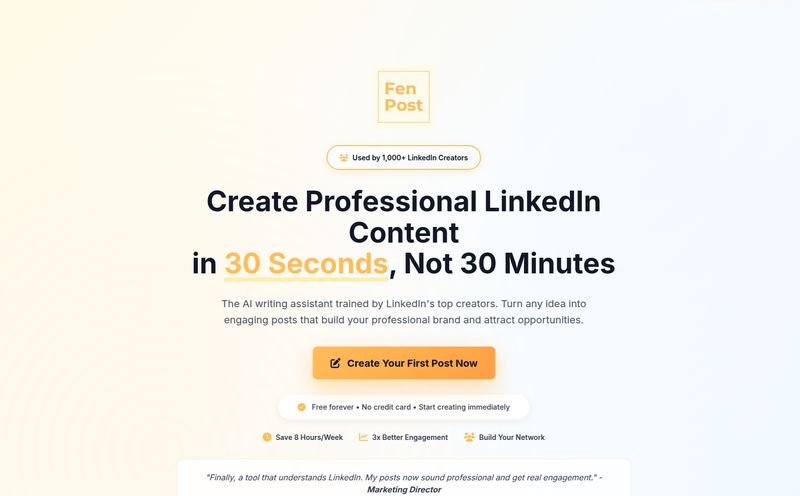If you've been in the architecture or design world for more than a minute, you know the rendering drill. The endless back-and-forth, the client who suddenly decides they want “a warmer wood, but not too warm,” the hours spent watching progress bars, praying your machine doesn’t crash. It's a process. A long, expensive process.
I’ve been in this SEO and digital trends game for years, and I’ve seen countless tools promise to revolutionize workflows. Most of them are just a fresh coat of paint on old ideas. But every so often, something pops up that makes you lean in a little closer. This time, it’s a platform called Rendair.
It’s making some bold claims about being an all-in-one AI rendering platform, turning your path from inspiration to final creation into a super-fast sprint. So, is it just hype, or is there some real fire behind all this smoke? I decided to take a look under the hood.
So, What Exactly is Rendair?
Think of Rendair as a hyper-intelligent assistant for architects and designers. Instead of spending days setting up lighting, textures, and camera angles in traditional software like V-Ray or Lumion, Rendair uses AI to do the heavy lifting. The whole point is to generate high-quality, photorealistic visuals for real estate and design projects, and to do it fast.
It's not just for the seasoned pros with beastly workstations, either. The platform seems designed to be accessible, to democratize the ability to create stunning visuals without a PhD in 3D modeling. It’s like Midjourney got a degree in architecture and decided to specialize. A fascinating proposition, right?
The Magic Behind the Curtain: Rendair's Core Features
Okay, let's get to the good stuff. What can this thing actually do? The landing page lays out a whole suite of tools that, on paper, cover pretty much every stage of the conceptual design process.
From Napkin Sketch to Photorealistic Reality
This is where things get exciting for the creatively-minded. Rendair offers multiple ways to bring an idea to life from scratch. You’ve got the classic 'Text to render,' where you describe your vision—say, “A modern Zaha Hadid-style house in a desert landscape at sunset”—and the AI gets to work. This is the feature that gets all the headlines, but as we’ll discuss, it’s a skill in itself.
Then there’s 'Sketch to render.' I love this. I remember countless meetings trying to translate a quick sketch on a notepad into something a client could understand. The idea of scanning that rough doodle and getting back a polished concept render is… well, it’s frankly brilliant. It bridges that gap between raw idea and presentable concept in a way that feels almost like magic. It also offers a simple 'Image to render', allowing you to upload an inspirational photo and have the AI create something new based on it.
Working with What You Already Have
For the professionals who are already partway through a project, Rendair isn’t trying to reinvent your whole workflow. It meets you where you are. If you have architectural plans, you can use the 'Elevation to render' feature to instantly visualize a flat drawing in 3D. If you’ve already built a basic model, the '3D base to render' tool can take your simple massing and turn it into a stunning, fully-textured image.
This is a massive efficiency play. It cuts out the tedious, time-sucking part of the process, letting designers focus on the big-picture stuff instead of minute material details for an initial concept presentation.

Visit Rendair
More Than Just a Pretty Picture: The Iteration Tools
Creating the first image is only half the battle. We all know the real work begins with the feedback. “Can we see it with more windows?” “What would it look like in brick?” “Make the logo bigger!”
Rendair seems to have anticipated this. Its suite includes tools for 'Image editing' (adding or removing objects), an 'Upscale' feature to get your images pixel-perfect and print-ready, and my personal favorite, 'Make image variations.' This lets you take one render you like and generate endless alternatives with a single click. It’s the perfect answer to an indecisive client, giving them options without sending you back to the drawing board for another 48 hours. They even have a 'Create AI video' tool to add motion to a still image, perfect for a quick social media clip or a more dynamic presentation.
But What's the Catch? A Realistic Look
Alright, I've been in this industry too long to believe in a perfect tool. While Rendair looks incredibly promising, there are a few things that give me pause.
First, the reliance on AI, especially for text-to-image, means you’re at the mercy of the algorithm. Getting a great result isn't about just typing a sentence; it’s about learning the art of prompting. It's a new skill. You have to learn how the AI “thinks” to guide it effectively. This isn't a flaw, per se, but it's a learning curve users should be aware of. You can't just expect miracles on your first try.
Second, and this is a personal pet peeve, is the pricing. The website has a 'Pricing' link, but the landing page itself doesn't list any plans or numbers. You have to book a demo or dig deeper. C'mon guys, just give us a ballpark! In my experience, this usually means it's targeting enterprise clients or the pricing is on the higher side. A little transparency would go a long way.
Who Should Actually Be Using Rendair?
So, who is this for? I dont think it’s here to replace entire visualization departments at massive firms like SOM or Gensler—not yet, anyway. Those teams do incredibly detailed, bespoke work.
Where I see Rendair shining is with:
- Solo architects and small firms: It gives them the power of a full rendering team without the massive overhead.
- Interior designers: Quickly mocking up room concepts and material changes would be a breeze.
- Real estate developers and marketers: They can generate marketing visuals for a property long before a single brick is laid, and create variations for different campaigns.
It's for anyone who needs to visualize ideas quickly and beautifully, especially in the early to mid stages of a project. It’s an accelerator, a tool for creative exploration on a deadline.
Learning and Community Support
One thing I do appreciate is the 'Learn with Rendair' section. They have tutorials on the basics, and even more advanced topics like designing over Google Maps images. This shows they understand that users need some guidance. It’s not just a “here’s the tool, good luck” situation. They also mention a “creator community,” which could be a fantastic resource for sharing tips and prompts—something that has been invaluable for users of other generative AI tools.
Frequently Asked Questions about Rendair
- What is Rendair primarily used for?
- Rendair is an AI-powered platform designed for fast, high-quality architectural rendering. It's used by architects, designers, and real estate professionals to visualize projects from sketches, text descriptions, 3D models, or existing images.
- Do I need 3D modeling skills to use Rendair?
- Not necessarily. While you can upload 3D bases, many of its core features, like 'Text to render' and 'Sketch to render,' are designed to work without any prior 3D experience. However, understanding design principles will certainly help you get better results.
- How much does Rendair cost?
- The specific pricing for Rendair isn't listed publicly on their main page. You typically need to contact them or book a demo to get details on their plans and pricing structure.
- Can Rendair create animations or videos?
- Yes, it has a feature called 'Create AI video' which allows you to add motion to a static rendered image, creating simple animations or fly-throughs.
- Is Rendair a replacement for traditional rendering software?
- For rapid concepting and iteration, it's a powerful alternative. For highly detailed, final construction-grade renders, traditional software may still offer more granular control. Many professionals might use Rendair for the initial phases and a tool like V-Ray for the final, polished output.
My Final Thoughts on Rendair
So, is Rendair the future? I think it’s a very significant part of it. Tools like this are fundamentally changing creative workflows, making them faster, more agile, and more accessible. It puts incredible power into the hands of creators, automating the tedious stuff so they can focus on what really matters: the ideas.
It's not a magic button that will solve all your problems. You still need a good eye and a clear vision. But as an intelligent, tireless creative partner, Rendair looks like an absolute beast. It represents a shift from brute-force creation to smart, collaborative design with AI. And frankly, I'm excited to see where it goes.



